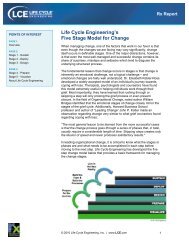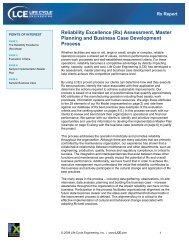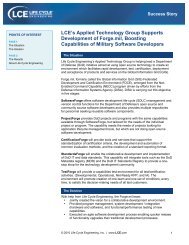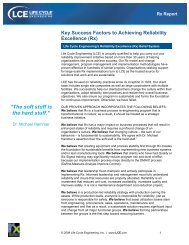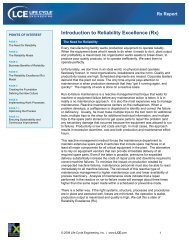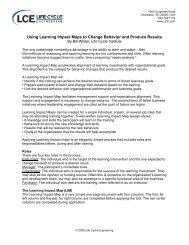Equipment Maintenance Plans - Life Cycle Engineering
Equipment Maintenance Plans - Life Cycle Engineering
Equipment Maintenance Plans - Life Cycle Engineering
You also want an ePaper? Increase the reach of your titles
YUMPU automatically turns print PDFs into web optimized ePapers that Google loves.
It is always best to consider the manufacturer's recommended maintenance for<br />
equipment, but you must also consider the equipments operating environment is<br />
and the frequency of operation. You would not want to change the oil in the<br />
pedestal of a pump on a quarterly frequency if the pump is in a clean<br />
environment and is operated very infrequently. Nor would you want to change the<br />
oil in an engine on an annual basis if the engine runs very frequently and is in a<br />
harsh environment. You must consider the operating context of the equipment<br />
and make informed decisions on maintenance needs.<br />
After you have determined the maintenance tasks that need to be performed, the<br />
next thing to include on the EMP is the skilled craft required to perform the<br />
maintenance. These crafts or skills are generally the same as those employed at<br />
the facility or plant. It is not unusual, though, to include maintenance tasks that<br />
require skills that are not available in house and must be contracted out. For<br />
these you may enter "CONT" or another code for the contracted craft<br />
designation.<br />
The number of craftsmen needed is also important. If more than one person is<br />
needed it must be identified and included so the man-hours calculated for the<br />
year will reflect using the extra personnel. Although some tasks must be multicraft,<br />
it is recommended that each maintenance task be developed for a specific<br />
craft. Develop single craft requirements, and then schedule multi-crafts together<br />
as required.<br />
Identify and include in the “TYPE” column the type of maintenance, for example,<br />
preventive (PM), corrective (CM), predictive (PdM) and situational (SIT) (based<br />
on meter hours, analysis results, special events, etc.)<br />
If you are assigning unique procedure/task codes or numbers to each<br />
maintenance procedure the first thing to decide is the format for these numbers<br />
or codes. It is extremely important to only use codes that can be accepted by<br />
your computerized maintenance management system or work order system.<br />
Even if you do not have to meet the criteria for a computer program it is important<br />
to use a consistent and logical number or code that is easily recognized.<br />
An estimated time required to perform the maintenance task is used to determine<br />
what the annual man-hour requirement will be for planning and budgeting. This<br />
estimated time should include the total time it will take to perform the<br />
maintenance action. Only enter the time it would take for one person to do his<br />
part of the work. If you are using a spreadsheet to develop the EMP, and the<br />
formulas are set up correctly, the time will be multiplied by the number of<br />
craftsmen and the frequency to determine the annual man-hours.<br />
The special tools and materials that are required to perform the maintenance<br />
also need to be captured and included on the EMP. These can be as simple as<br />
the need for a torque wrench that is not normally found in the mechanics toolbox.<br />
These can also be major items like a man-lift, refrigerant recovery machine,<br />
boiler combustion test kit, etc.<br />
© 2009 <strong>Life</strong> <strong>Cycle</strong> <strong>Engineering</strong>, Inc. | www.LCE.com 4



